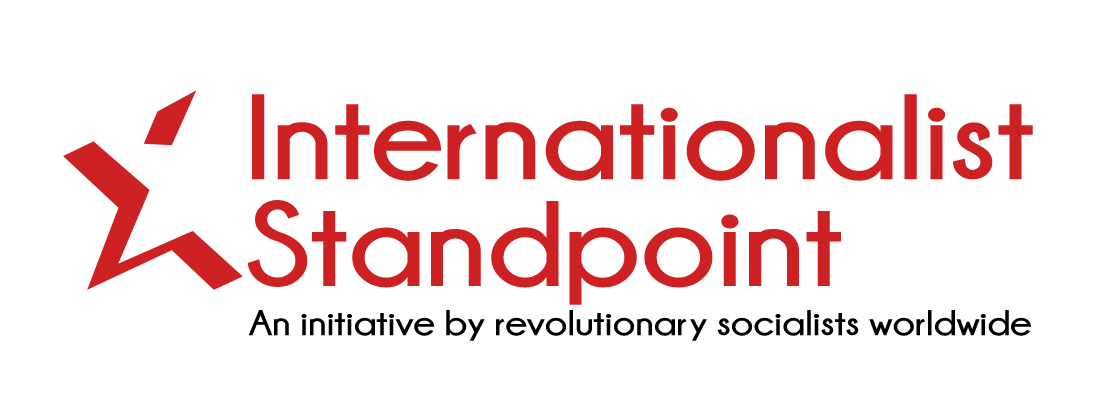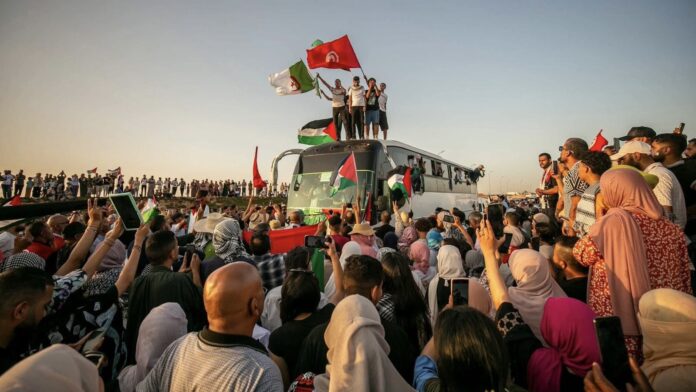Ecehan Balta, Nikos Anastasiadis
On June 15, 2025, movements and organisations across more than thirty countries mobilised simultaneously in support of Gaza under the banner of the Global March to Gaza. Coordinated by an international coalition of over 300 organisations—including trade unions, cultural networks, feminist collectives, political parties and student groups—the initiative called for an immediate end to the siege, the permanent reopening of the Rafah crossing, and the establishment of a humanitarian corridor.
While the physical march toward the Rafah crossing was obstructed by Egyptian authorities, the scale and breadth of international solidarity actions highlighted a growing mood of resistance that transcends state borders. It was an important hallmark of the Gaza movement which tries to organise more concrete actions and of a more internationalist character. In total, 52 countries organised delegations for the March to Gaza.
Blockade at the Border
The action started with the Mahreb Soumoud Convoy travelling from Tunisia through Libya and towards Palestine, with thousands of participants.
Three days before the scheduled action, Egyptian authorities began implementing sweeping restrictions. International participants arriving in Cairo were detained at the airport, interrogated without legal representation, and in some cases deported within hours. Participants from Europe, North Africa, and the Americas were refused entry despite having provided advance documentation.
On June 14, convoy buses departing from Cairo en route to Rafah were intercepted near Ismailia. Egyptian security forces halted the vehicles approximately 30 kilometers from the Suez Canal. Foreign nationals were removed from the buses, isolated, and in many cases denied access to water or communication tools. Mobile phone signals were reportedly jammed in the area. No official explanation was offered beyond general statements about “national security.”
Participants remained in desert heat for several hours. Some staged sit-ins near the halted convoys, displaying banners and chanting slogans, while others attempted to negotiate with security personnel. Egyptian nationals who attempted to assist foreign participants were also questioned.
Testimonies from the Convoy
Among those present at the border was Leïla, a 27-year-old activist from France affiliated with a feminist collective. She described the experience in the following terms:
“We were stopped before sunrise. Our passports were taken. Some were separated by nationality. We were left without water in the sun for hours. One officer said, ‘If you come for peace, you don’t belong here.’ We decided to stay.”
Another participant, Ahmed, a 61-year-old doctor from Sudan, shared his perspective:
“I came to help treat war-injured children. Instead, we were blocked from reaching them. I now believe that standing here, even in silence, is also a form of protest.”
These testimonies are representative of dozens collected from activists, suggesting deliberate attempts by the Egyptian government to undermine the legal right to peaceful assembly and humanitarian engagement. They also serve as a proof that the Arab regimes in the area, although engaging in a discourse about “solidarity with the Palestinians”, do everything they can to not disturb the Israeli state.
Parallel Actions Around the World
As convoys were obstructed in Sinai, mass protests and solidarity actions took place across cities in Europe, Asia, Africa, and the Americas. The Hague hosted the largest turnout, with an estimated 150,000 participants forming a red-clad human chain from the International Criminal Court to the Dutch Parliament. Protesters referenced the 2024 ICJ ruling on Gaza and demanded its enforcement.
In Brussels, demonstrators marched along Rue de la Loi, blocking traffic near EU institutions, in a 100.000-strong demonstration. In Jakarta, a large-scale procession moved between the United States and Israeli embassies, with significant participation from local civil society groups and public figures. Symbolic processions took place in Istanbul, São Paulo, and Cape Town. In Greece, protests were organised in 37 cities, while the demonstration in Greece was 10.000-strong.
Importance
The mobilisation represented a new phase in international solidarity strategies, combining traditional protest tactics with logistical attempts to physically approach restricted areas.
Among the convoy’s most striking elements was the Madleen, a UK-flagged aid vessel named after Gaza’s first female fisher, which departed from Catania on June 1, carrying essential supplies—baby formula, rice, flour, diapers, medical kits, crutches, etc. It was intercepted in international waters by Israeli forces on June 9, after which its crew was detained and deported. The Madleen’s voyage and the attempt to physically approach Gaza’s border, together with mass protest in different parts of the world, embodied an escalation in solidarity tactics to challenge the legal legitimacy of the blockade.
Parts of the anti-war movement are looking for ways to have a practical impact on the continuation of the genocide. In February, 1,000 activists staged a sit-in outside Maersk’s HQ in Copenhagen with the slogan “Mask Off Maersk – Cut Ties from Genocide” and the demand for the transport company to stop transporting military-related equipment to Israel. In Sweden, France, Italy, Spain and Greece, dockworkers refused to handle war material en route to Israel.
It is important to note that there is also an ongoing, modest but hugely brave and important movement inside Israel against the genocide (watch here).
Need to continue
Activists remaining near the Rafah crossing have declared a peaceful sit-in lasting until June 19. Legal teams are preparing habeas corpus filings for deported participants, and several organisations have launched appeals to the UN Special Rapporteur on the Rights to Freedom of Peaceful Assembly and Association. Some participants remain detained and there is a campaign for their release.
The Global March to Gaza has served to amplify the urgency of the humanitarian crisis in Gaza and the growing pressure on governments to cut ties with the Israeli war machine. While the Egyptian border remained closed, the convergence of thousands in streets and deserts alike marked a new threshold of international coordination.
The global movement against the genocide in Gaza must explore ways to organise and coordinate so it can maximize the pressure. In this context, strikes and boycotts are extremely important in order to deliver hits to the Israeli state’s capacity to find the war. Ongoing efforts to divest from company and academic common projects with Israeli firms are also important, and they should take a local character, involving local communities. Mass protests should continue to exert pressure on governments with the aim to isolate the Netanyahu regime as much as possible, out of fear for political costs.
The power of working people lies in their ability to stop the production and circulation of goods and materials. The anti-war movement should focus on using this massive strength to choke the Israeli war machine, on military and economic fields. Factories producing arms or relevant parts for Israel should be targeted for strikes and disruption. Workers in ports and freight trains should mobilise to stop the flow of cargos. The same goes for workers in IT companies that support the Israeli army. In general, there are a lot of people that want to do something to stop the support for the genocide, and the leaderships of working class organisations have the duty to find ways to utilise this collective power.
Overall, the battle to put a break in the genocidal campaign should remain a priority for the mass organisations of the working class.
To follow the March, please visit https://marchtogaza.net/



